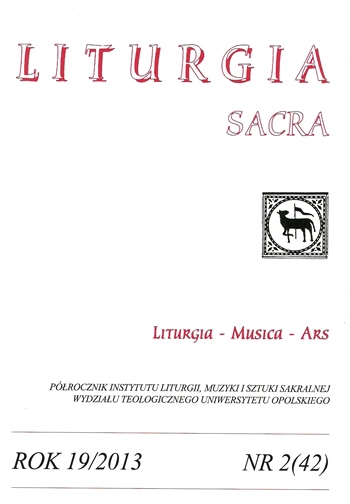Drogi i bezdroża muzyki kościelnej w Polsce po Soborze Watykańskim II
Paths and Backwoods of Polish Church Music After Vaticanum II
Author(s): Joachim WaloszekSubject(s): Christian Theology and Religion, Fine Arts / Performing Arts, Music, Essay|Book Review |Scientific Life, Cultural Essay
Published by: Uniwersytet Opolski
Keywords: Polish Church Music; Vaticanum II
Summary/Abstract: The liturgical reform of Vaticanum II, started fifty years ago with the announcement of the Constitution on the Sacred Liturgy (Sacrosanctum Concilium), changed significantly also the musical dimension of the liturgy celebrated in Polish churches. There are two vectors of the conciliar reform which seem to determine the mainstream of those changes. Firstly, the participatio actuosa requirement, which in consequence led to both the extension of the conceptual range of musica sacra by adding the concepts of folk art and folk hymn, and the appreciation of the vernacular and native roots present in the church singing. Secondly, the requirement concerning the theological purification and intensification of the contents of ecclesiastical rites, so also the church singing involved in the liturgy. Throughout the recent fifty years, the Catholic Church in Poland has made much effort to promote new compositions and musical praxis in liturgy as well as to give it proper orientation and dynamics. As a result, not only has the repertoire been enriched with reference to quantity and content, but also the general quality of musical output in churches has risen. What is more, the number of qualified musicians and organizers of musical activities in parishes has increased, although still not satisfactorily. However, it does not mean that in the past as well as at present there have not been obstacles on the way to implement the conciliar ideals and postulates. The reform of church music is still conditioned by many tensions and seeks its adequate way placed somewhere between the validity of Church Law and the artistic autonomy, aesthetics and pastoral pragmatism, avant-garde and tradition, between sacrum and profanum. Reformative ideas, based on the inappropriately conceived criteria of modernity and pastoral pragmatism have happened to be misleading for church music directing it towards religious and musical kitsch, rubbish, primitive entertainment, banalization of art and, what follows, banalization of liturgy. The socio-political context of the Church reformative activities as well as the regrettable level of musical education in Polish society may only be partially blamed for such a state of things. To a great extent, it is also the result of the frequently inaccurately adjudged “conflict” which is somehow a part of the nature of the artistic activities undertaken by the Church. On the one hand, such art wants and even has to defend its aesthetic autonomy and artistic qualifications. On the other hand, its advocates want to remain submissive as servants of Christian prayer. Each generation is engaged anew in the challenge of undertaking and “easing” these natural tensions and conflicts in order to find the so-called “golden mean”. Only the incessant deepening of both the theological consciousness and the aesthetic sensitivity would assure the right course of action. As a consequence, it may be pointed out that what church music nowadays needs most is the just and patient liturgical and musical education of both priests and the people.
Journal: Liturgia Sacra
- Issue Year: XIX/2013
- Issue No: 42
- Page Range: 397-405
- Page Count: 9
- Language: Polish
- Content File-PDF

